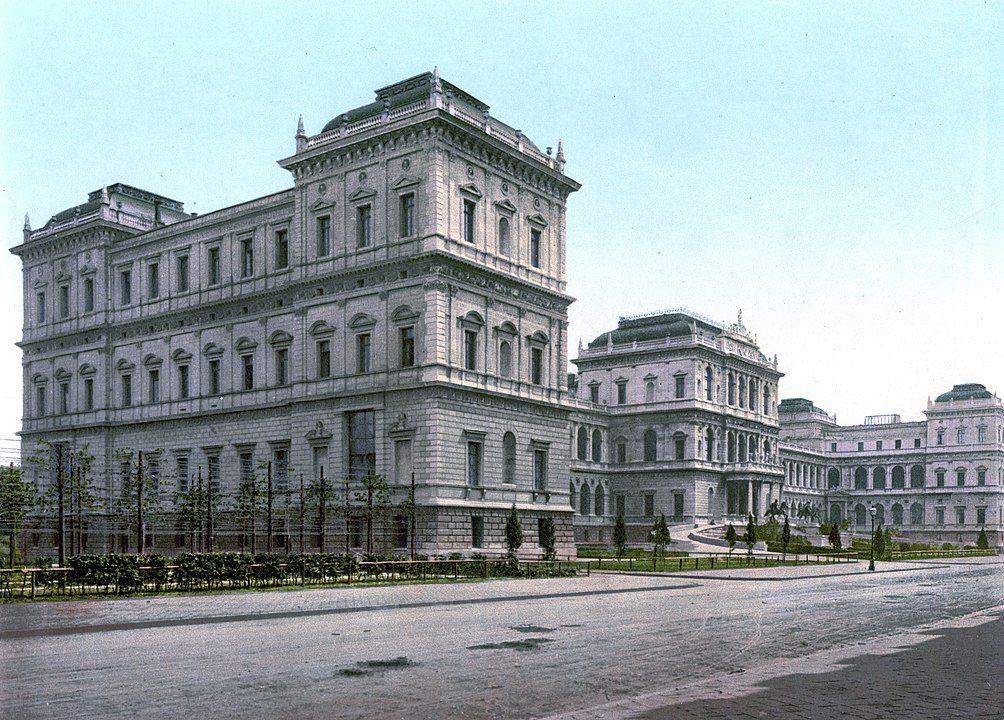
The Academy of Fine Arts Munich was founded in 1808 by King Maximilian I of Bavaria. His vision was to establish a formal institution that would elevate the artistic capabilities of the kingdom and secure Bavaria’s place as a cultural stronghold within Europe. The early 19th century was marked by a surge of national pride, and establishing an elite academy reflected the monarchy’s commitment to education, order, and aesthetic tradition. It was part of a broader wave of state-sponsored institutions that reinforced identity through the arts.
The Academy was initially modeled on earlier European art schools, particularly drawing inspiration from the Accademia di Belle Arti di Firenze and the École des Beaux-Arts in Paris. The goal was to provide classical training in painting, sculpture, and architecture. The curriculum emphasized technical mastery, historical themes, and religious iconography, which aligned with the conservative sensibilities of post-Napoleonic Europe. Students trained extensively in anatomy, perspective, and historical drawing—skills deemed essential for any respectable artist.
Johann Peter von Langer, born in 1756, served as the first director and laid down the core educational principles of the academy. He had previously worked at the Düsseldorf Academy and brought with him a strict commitment to Neoclassicism. Under von Langer’s direction, the institution recruited highly trained faculty and quickly became known for its disciplined approach. The Academy’s location in the heart of Munich helped anchor it within the city’s artistic and political elite.
In those early years, the Academy was housed in a modest but stately building that reflected its classical roots. It was located near the Odeonsplatz, surrounded by civic architecture and cultural monuments. Students often participated in public competitions, and winning them could lead to royal patronage or international recognition. The Academy quickly grew in stature, becoming not just a school but a symbol of Bavarian refinement and cultural legitimacy.
The Academy’s Golden Age in the 19th Century
By the mid-19th century, the Academy of Fine Arts Munich had entered what many call its “Golden Age.” This period saw an influx of talented students, visionary instructors, and a spirit of creative ferment that would define European art for generations. As Romanticism gave way to Realism and eventually early Modernism, the Academy remained at the forefront of stylistic evolution. It was during these decades that the school earned its reputation as one of the leading art institutions in Europe.
Wilhelm Leibl, born in 1844, is one of the most celebrated alumni from this era. Known for his meticulous realism and moral seriousness, Leibl’s work carried the intellectual rigor of German philosophical traditions. He studied under Karl Theodor von Piloty at the Academy, and his friendships with fellow students formed what would later be called the “Leibl Circle.” These relationships went beyond camaraderie—many would influence Germany’s approach to naturalistic and narrative painting well into the 20th century.
Another towering figure of the Academy’s 19th-century output was Franz von Stuck, born in 1863. A key contributor to Symbolism, von Stuck eventually joined the faculty and helped revolutionize the curriculum to include more modern, expressive techniques. He was both painter and architect, a fusion of disciplines that signaled a departure from strictly classical ideals. His influence is evident in the visual language of German Jugendstil, and he personally mentored many students who would later rise to fame, including Paul Klee and Wassily Kandinsky.
The Academy’s role in the founding of the Munich Secession in 1892 marked a turning point. The Secession was a rebellion against the state-controlled art exhibitions and an assertion of artistic freedom. Many of its members were Academy-trained artists disillusioned by bureaucratic constraints. This movement connected Munich to similar efforts in Vienna and Berlin, helping to spread a more expressive, less dogmatic vision of art throughout Europe. The Academy had become a crucible for innovation—by tradition and defiance alike.
Twentieth-Century Challenges and Political Turmoil
The 20th century began with promise but quickly turned turbulent for the Academy. World War I shattered much of the optimism that had characterized the late 1800s, and with Germany’s defeat came economic hardship, social upheaval, and political extremism. The Academy managed to stay open during the war, but faculty and students alike were drafted into military service. Many never returned, and the institution’s halls echoed with both silence and grief in the postwar years.
As the Weimar Republic took shape, the Academy found itself in a strange position—caught between the democratic openness of the new era and the rising tide of nationalism. During the 1920s, some instructors tried to modernize the curriculum and embrace new movements like Dadaism and Expressionism. However, this openness was not to last. When the National Socialist regime came to power in 1933, the Academy was forced to purge what it labeled “degenerate art” and fell into ideological submission.
Paul Klee, born in 1879 and briefly a student in Munich, became a target of this cultural purge. Though more closely associated with the Bauhaus, Klee had deep connections to the Academy and Munich’s art scene. He was dismissed from his teaching post in 1933 and later emigrated to Switzerland. Artists like Kandinsky—who had ties to the Academy through exhibitions and early study—also fled the country, fearing persecution for their nonconformist art and political views.
Under the Nazis, the Academy became a tool for propaganda. Adolf Ziegler, one of Hitler’s favorite painters, helped enforce a rigid and backward-looking aesthetic centered on Aryan ideals and pastoral romanticism. The once-thriving halls were filled with portraits of soldiers, mothers, and empty heroics. During the Allied bombings of Munich, parts of the Academy were destroyed. It wasn’t until after the war that serious efforts at reconstruction—both physical and ideological—would begin.
Post-War Revival and Modernization
Following Germany’s surrender in 1945, the Academy of Fine Arts Munich faced a daunting path toward redemption and recovery. The physical damage to its facilities was extensive, with portions of the original buildings reduced to rubble. However, the faculty and surviving students were committed to rebuilding not just walls, but a soul. The Academy reopened in stages during the early 1950s, a period marked by deep reflection, reconstruction, and the rediscovery of its original mission.
The new leadership took deliberate steps to distance the institution from its Nazi past. This included rethinking the curriculum, promoting freedom of expression, and hiring avant-garde faculty. No longer bound by strict classical rules, students explored abstraction, performance, and multimedia. Painting was still taught, but now as a tool of inquiry rather than dogma. The 1950s and 1960s saw the Academy reemerge as a place where tradition and experimentation were not enemies but collaborators.
Günther Förg, born in 1952, is a standout figure from this post-war revival. Though he graduated in the 1970s, his abstract works and photography challenged conventions and won international acclaim. The Academy also drew figures like Georg Baselitz into its orbit. Although Baselitz studied primarily in East Berlin, he engaged with Munich-based artists and was influenced by the Academy’s post-war transformations. These artists redefined German art by processing national trauma through innovative forms.
By the 1980s, the Academy had fully reclaimed its position among Europe’s elite art institutions. Its facilities were expanded, with new studio buildings and modern infrastructure added alongside restored historical spaces. The student body grew increasingly diverse, with applications coming from across the globe. The Academy no longer stood as a relic of the past—it had become a dynamic laboratory for contemporary art, firmly rooted in the lessons of history but focused on the future.
Influential Teachers and Alumni Across Centuries
One of the enduring strengths of the Academy of Fine Arts Munich lies in its illustrious list of alumni and faculty, many of whom helped shape the course of European art. Wassily Kandinsky, born in 1866 in Moscow, studied in Munich in the 1890s and attended classes at the Academy before helping to found the Blue Rider group in 1911. His time in Munich and exposure to the Academy’s teachings helped him transition from representational art to abstraction. Kandinsky later became one of the most important figures in 20th-century art.
Gabriel von Max, a Czech-German painter born in 1840, also taught at the Academy and was known for his deeply symbolic and spiritual paintings. His interests included anthropology, zoology, and mysticism, which he often incorporated into his work. As a professor, he encouraged students to pursue themes that transcended the material world. He mentored many young artists who would later distinguish themselves for blending realism with spiritual inquiry.
Alfred Kubin, born in 1877, is another significant alumnus. Known for his haunting drawings and fantastical imagery, Kubin was deeply influenced by the Symbolist movement and often explored themes of death, dreams, and madness. Though his time at the Academy was brief, it left a lasting impression. Kubin’s legacy continues in the genre of dark, introspective graphic art, and his early interactions with the Munich art world were pivotal in his development.
Relationships among students were often as formative as those with faculty. Wilhelm Leibl’s circle, for example, included painters like Carl Schuch and Wilhelm Trübner, and their collaborations helped define German Realism. The Academy also became increasingly international in the 20th century, attracting students from Eastern Europe, Asia, and the Americas. These relationships enriched the institution’s cultural perspective and kept it in dialogue with global artistic currents, reinforcing its role as a creative hub.
The Academy Today: Programs, Facilities, and Vision
Today, the Academy of Fine Arts Munich remains one of Germany’s premier institutions for artistic education. It offers programs in painting, sculpture, graphic arts, and increasingly, digital and performance-based media. The modern curriculum balances historical techniques with contemporary approaches. Students are encouraged to find their own voices, with support from world-class faculty and access to expansive studio spaces.
The Franz-von-Stuck building, named after the famed professor, has been updated to serve the needs of 21st-century students. Workshops now include facilities for metalworking, ceramics, and even virtual reality. The Academy regularly hosts public exhibitions of student work, providing crucial real-world exposure. Lecture series, visiting artist programs, and interdisciplinary seminars make the Academy a vibrant place of exchange and growth.
Faculty today include living artists who are active on the international scene. Professors frequently exhibit in biennials and major galleries, and they bring that professional experience into their teaching. This ensures students are not just trained as craftsmen but are prepared to engage with the contemporary art world. They are taught to think critically, to challenge norms, and to respect the weight of tradition even while pushing boundaries.
The Academy also partners with institutions across the globe. Exchange programs with the U.S., Japan, and throughout Europe allow students to broaden their horizons. Munich itself, with its thriving museum district—including the Pinakothek der Moderne—offers endless inspiration and opportunities for exposure. The Academy’s integration with the city and international networks makes it not just a school, but a gateway to a larger artistic universe.
Legacy and Cultural Impact in the Art World
The Academy’s legacy reaches far beyond Bavaria. Its graduates and faculty have shaped major movements in art history, from Symbolism to Abstract Expressionism. The institution’s conservative roots gave it a firm foundation, but it has evolved to accommodate freedom, complexity, and innovation. This dual nature—anchored in tradition yet open to change—gives the Academy a unique voice in global discourse.
Works by Academy alumni hang in the world’s most prestigious museums, including the MoMA in New York, the Tate Modern in London, and Berlin’s Neue Nationalgalerie. Many graduates go on to lead art schools, head curatorial departments, or influence cultural policy. The Academy’s emphasis on intellectual depth and technical excellence remains its signature contribution. Its standards are high, and its influence enduring.
The institution has also been a participant in broader social debates about art’s role in society. Whether resisting totalitarianism, advocating for artistic freedom, or debating the role of AI in creative work, the Academy stands at the crossroads of culture and policy. While it welcomes change, it does so with discernment—honoring timeless values like craftsmanship, discipline, and the moral responsibility of the artist.
As we move further into the digital age, the Academy continues to adapt. It is investing in new technologies, incorporating environmental themes, and exploring interdisciplinary practices. Yet through all this change, it remains steadfast in its purpose: to educate artists who are both technically capable and intellectually grounded. The Academy of Fine Arts Munich is not just a school—it is a cultural institution with a soul that refuses to fade.
Key Takeaways
- Founded in 1808, the Academy reflects Bavaria’s deep cultural roots.
- It played a vital role in 19th-century European Romanticism and Realism.
- The Academy endured political suppression during the Nazi era but rebuilt post-WWII.
- Major figures like Kandinsky, Leibl, and von Stuck shaped global art movements.
- Today, it thrives as a modern, internationally respected art institution.
FAQs
- Who founded the Academy of Fine Arts Munich?
King Maximilian I of Bavaria founded it in 1808 as a state-supported institution. - Which famous artists studied or taught there?
Notables include Kandinsky, Leibl, von Stuck, Paul Klee, and Alfred Kubin. - How was the Academy affected by WWII?
It suffered physical damage and ideological corruption but was rebuilt in the 1950s. - What programs does the Academy offer today?
It offers traditional disciplines like painting and sculpture as well as digital and performance arts. - Is the Academy involved in international partnerships?
Yes, it has student exchanges and collaborations with institutions across the globe.




